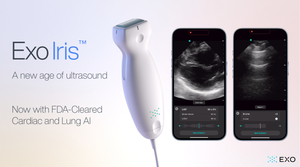June 3, 2009
Originally Published MPMN June 2009
BREAKTHROUGHS
Non-MEMS Scanner Supports Portable Imaging Systems
Click to enlarge |
A non-MEMS resonant scanner developed by EOPC offers larger mirror sizes than MEMS-based scanners in a small overall package size. |
Portable and handheld imaging technologies are emerging as the next wave of point-of-care diagnostic devices. Notably represented by the introduction of portable and handheld ultrasound systems, these point-of-care products help to expedite diagnosis and, subsequently, treatment of patients.
Making these portable imaging systems possible is the miniaturization of internal components, which, in turn, contributes to the reduction of the overall system package. One such miniaturization-enabling technology is the SC-3-type non-microelectromechanical systems (MEMS) resonant scanner, which, according to manufacturer Electro-Optical Products Corp. (EOPC), is the smallest non-MEMS resonant scanner currently on the market.
“People are always pushing for something smaller,” says EOPC chief engineer Israel Tuchman. “This is the smallest [scanner] we were able to produce without going to a completely different technology, like MEMS.”
Measuring 0.9 × 0.5 × 0.4 in., the subminiature fixed-frequency resonant optical scanner is an electromagnetically driven moving mirror device that deflects a light beam with a sinusoidal motion. It is the SC-3’s mirror size, says Tuchman, that truly differentiates the product from MEMS-based scanners. A mirror in a MEMS-based scanner is typically about 1 × 1 mm, he notes. In contrast, EOPC’s technology allows for a 6-mm-diameter mirror in either 7 × 7- or 12 × 7-mm size options. Additional mirror features of the SC-3 scanner include a ¼ wavelength flatness for the smaller version and ½ wavelength for the larger mirror. The mirror is also offered with a standard thickness of 1 mm, an optical scanning angle up to 50°, and a fixed-frequency scanning range from 100 to 1000 Hz.
Along with having a larger mirror option, the non-MEMS product boasts additional benefits, according to Tuchman. “The advantage of having a resonant scanner is that it requires very little power,” he explains. “It also doesn’t need any bearings or other parts and can run for infinite times without failing.” A wide temperature range, low electrical drive, and frequency stability are additional features.
This combination of features, coupled with scan repeatability and a high flexural stiffness that provides good shock and vibration resistance, establishes the optical scanner as a suitable component for applications requiring good imaging with minimal distortion. Potential medical applications include portable and handheld imaging systems, as well as imaging systems for improving cancer diagnosis, ophthalmic imaging instruments, adaptive optics, optical coherence tomography, x-ray technology, DNA sequencing, and brain imaging and detecting cognitive recognition.
Electro-Optical Products Corp.
Fresh Meadows, NY
www.eopc.com
Copyright ©2009 Medical Product Manufacturing News
You May Also Like



